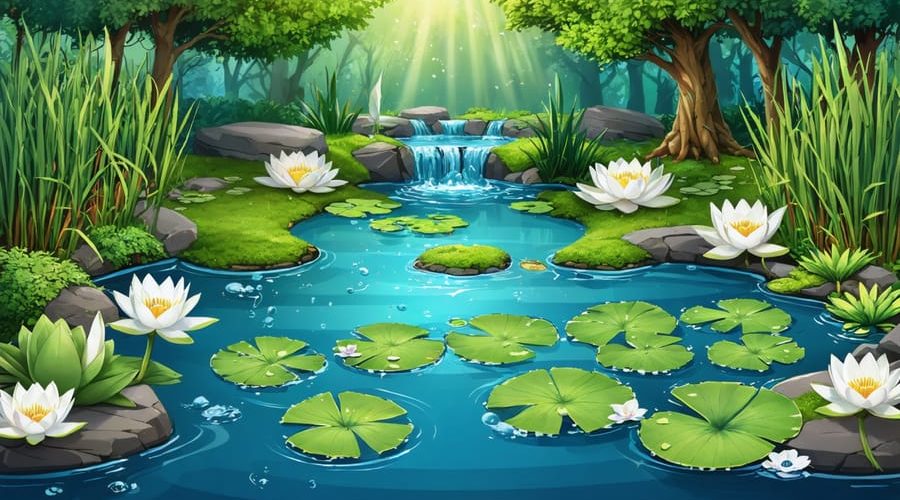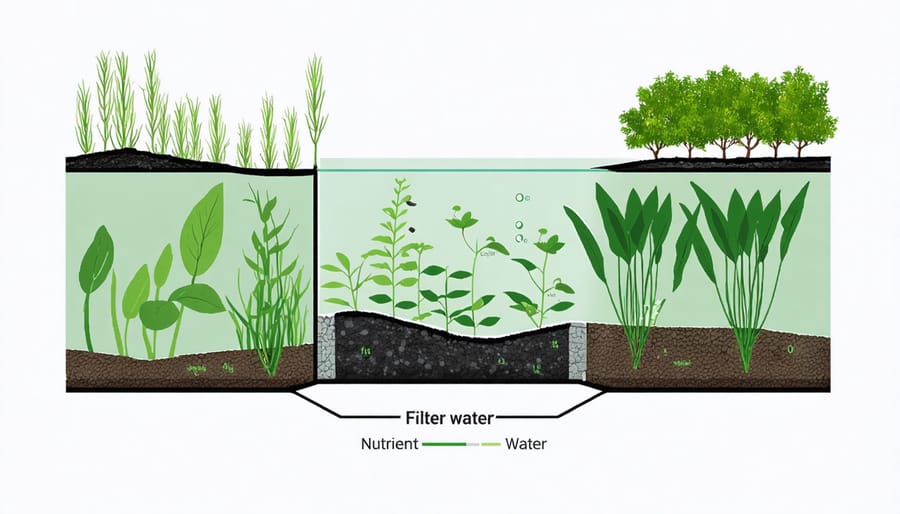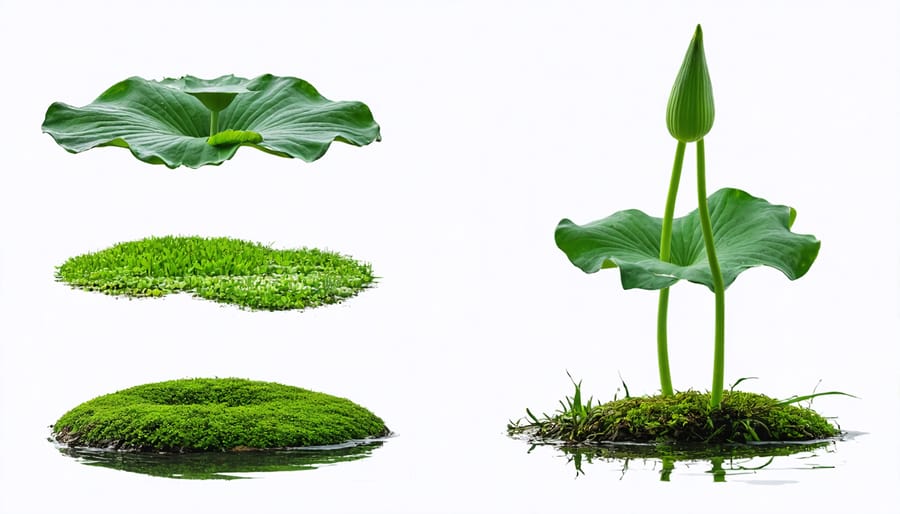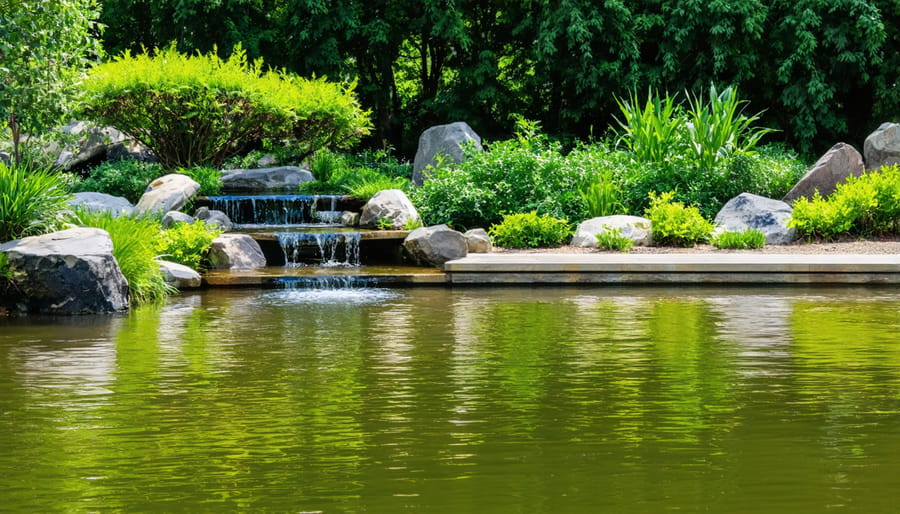
How Pond Plants Transform Your Water Garden into a Natural Filter
Transform your pond into a self-sustaining ecosystem with nature’s most efficient filtration system – aquatic plants. These living filters not only purify water by absorbing excess nutrients and harmful compounds but also create stunning visual interest while providing vital habitat for wildlife. Plant-based filtration systems work round the clock, reducing maintenance costs and chemical dependencies while maintaining crystal-clear water naturally.
Marginal plants like cattails and rushes form the first line of defense, trapping sediment and processing organic waste at the pond’s edge. Floating plants such as water lilies shade the surface, limiting algae growth and regulating water temperature. Beneath the surface, submerged oxygenators like hornwort work tirelessly, releasing oxygen and filtering microscopic particles from the water column.
Unlike mechanical filters that require regular cleaning and replacement parts, a well-designed plant filter becomes more effective over time as root systems develop and beneficial bacteria colonies establish themselves. This natural approach to water filtration doesn’t just clean your pond – it creates a thriving, balanced ecosystem that’s both beautiful and remarkably low-maintenance.
The Natural Filtration Process
Nutrient Absorption
Plants in your pond act like nature’s cleaning crew, working tirelessly to remove excess nutrients that could otherwise lead to algae problems. Through their roots, stems, and leaves, these aquatic plants absorb nitrates, phosphates, and other waste products that accumulate from fish waste and decaying organic matter. Working alongside beneficial bacteria, plants help maintain a healthy balance in your pond ecosystem.
The absorption process is fascinating – plants take up these nutrients through their root systems, using them as food for growth. Think of them as natural recyclers, transforming potentially harmful waste into beautiful foliage and flowers. Different plants have varying appetites for specific nutrients, which is why having a diverse plant selection is key to effective filtration.
Fast-growing plants like water hyacinth and hornwort are particularly good at nutrient uptake, making them excellent choices for natural filtration. During the growing season, these plants can remove significant amounts of nitrogen and phosphorus, helping to keep your pond water crystal clear and reducing the likelihood of algae blooms.

Oxygenation Benefits
Plants in your pond do more than just look pretty – they’re natural oxygen powerhouses! During daylight hours, pond plants actively produce oxygen through photosynthesis, releasing it directly into the water. This process is especially beneficial for fish and other aquatic life that need oxygen-rich water to thrive.
Floating plants like water lilies and submerged plants such as hornwort are particularly effective at oxygenation. Their leaves create shade that helps regulate water temperature while their underwater portions release oxygen directly where it’s needed most. Even marginal plants along the pond’s edge contribute to the overall oxygen levels while creating a natural ecosystem.
Having a good mix of oxygenating plants is crucial – aim for about 60% of your pond’s surface to be covered with plants. This balance helps maintain healthy oxygen levels throughout the day and night. Remember that plants produce oxygen during daylight hours but consume some oxygen at night, so having the right amount is key to maintaining a healthy equilibrium in your pond ecosystem.

Best Plants for Natural Filtration
Submerged Plants
Submerged plants, also known as oxygenating plants, are the hidden champions of pond filtration. These powerhouse filtering plants grow completely underwater and work tirelessly to keep your pond clean and healthy.
Plants like Hornwort, Anacharis, and Water Milfoil absorb excess nutrients directly from the water through their leaves and stems. This unique ability makes them incredibly efficient at removing nitrates and phosphates that can lead to algae growth. They also provide valuable shelter for beneficial bacteria that help break down waste materials.
What makes submerged plants especially valuable is their ability to release oxygen during the day while absorbing carbon dioxide. This process helps maintain healthy oxygen levels for fish and other aquatic life. They’re also great at competing with algae for nutrients, naturally helping to keep your pond water clear.
For best results, aim to cover about 50-60% of your pond’s bottom with these plants. You can plant them in weighted bunches or secure them in planting baskets with aquatic soil. Remember to trim them occasionally to prevent overgrowth and remove any dead plant material to maintain water quality.
Choose varieties that suit your climate and pond depth. Most submerged plants thrive in depths between 2 to 5 feet, making them perfect for various pond sizes.
Floating Plants
Floating plants are nature’s perfect filtration helpers, creating a living blanket across your pond’s surface that works wonders for water quality. These plants, like water hyacinth and duckweed, spread their roots directly into the water, forming an extensive network that absorbs excess nutrients and filters out pollutants.
What makes floating plants particularly effective is their rapid growth and impressive nutrient uptake. They’re especially good at removing nitrogen and phosphorus, which are common culprits behind algae blooms. The shade they create also helps regulate water temperature and reduces algae growth by limiting sunlight penetration.
Popular floating plants for filtration include water lettuce, which features thick, fuzzy leaves and trailing roots that trap debris, and salvinia, known for its ability to absorb heavy metals from water. Frogbit is another excellent choice, particularly for smaller ponds, as it’s easier to control than some more aggressive floaters.
For best results, aim to cover about 50-70% of your pond’s surface with floating plants during the growing season. Be mindful that some floating plants can grow quite rapidly, so regular thinning may be necessary to maintain the right balance. In colder regions, you’ll need to bring tender floating plants indoors during winter or treat them as annuals.
Creating the Perfect Plant Filter System
Plant Placement
Strategic placement of your pond plants is crucial for achieving optimal filtration performance. Start by positioning taller marginal plants, like cattails and rushes, along the pond’s edge where water enters the system. These plants act as the first line of defense, catching larger debris and excess nutrients.
Create a graduated depth system, where plants are arranged from shallow to deep zones. Place floating plants like water lilies and water hyacinths in areas with good sun exposure, allowing them to spread their roots throughout the water column. These plants are excellent at absorbing excess nutrients and providing shade that helps control algae growth.
Ensure you use a proper plant substrate to anchor your plants and provide additional filtration benefits. Position submerged plants like hornwort and anacharis in deeper areas, creating underwater forests that trap fine particles and provide surface area for beneficial bacteria.
For maximum effectiveness, arrange plants so water flows through, rather than around them. Create small channels or zones where water must pass through dense plant growth. This slows water movement, allowing more time for plants to filter out impurities. Remember to leave some open water areas for fish movement and pond maintenance access.
Consider seasonal growth patterns when placing plants, allowing space for expansion during peak growing seasons. This thoughtful arrangement ensures your plant filter system remains effective year-round while maintaining an attractive appearance.

Maintenance Tips
Keeping your pond’s plant filter system in top condition doesn’t have to be complicated. Start by checking your plants weekly during the growing season for any dead or yellowing leaves, removing them promptly to prevent decay in the water. Trim back excessive growth monthly to maintain proper water flow and prevent plants from becoming too dense.
Every spring, divide and repot your filter plants to ensure they continue growing vigorously. Use fresh aquatic soil and remove any accumulated debris from the root systems. During this maintenance, check the plant baskets or containers for damage and replace them if necessary.
Monitor water levels regularly, especially during hot summer months, as healthy plants need consistent water depth to function effectively. In fall, cut back dying foliage but leave enough to protect the roots during winter. For submerged plants, maintain them at their optimal depth by adjusting their position as needed throughout the year.
Clean the area around your plant filter system monthly by removing any fallen leaves or debris that might clog the system. Test your water quality every few weeks to ensure your plant filter is working effectively. If you notice any decline in water clarity or quality, consider adding more plants or redistributing existing ones for better filtration.
Remember to avoid using chemical fertilizers near your filter plants, as these can promote unwanted algae growth. Instead, let natural debris feed your plants, maintaining the perfect balance in your pond ecosystem.
Plant and Fish Balance
Achieving the perfect balance between plants and fish in your pond is crucial for maintaining a healthy filtration system. Balancing plants and fish isn’t just about aesthetics – it’s about creating a self-sustaining ecosystem that keeps your water crystal clear.
A good rule of thumb is to cover about 60-70% of your pond’s surface with plants while maintaining appropriate fish stocks. For every 50 gallons of water, you can typically keep 1-2 inches of fish (measured at their full adult size). This ratio ensures your plants can effectively filter the waste produced by your fish.
To maintain this balance, consider these practical tips:
1. Start with fewer fish than your pond can theoretically handle. It’s easier to add more fish later than to deal with an overcrowded pond.
2. Include a mix of different plant types: floating plants for surface coverage, submerged plants for oxygenation, and marginal plants for nutrient absorption.
3. Monitor your water quality regularly. Clear water and healthy plant growth indicate a good balance.
4. Add plants gradually, allowing each addition to establish before introducing more.
5. Watch for signs of imbalance, such as:
– Excessive algae growth (too many fish or too few plants)
– Yellowing plant leaves (possible nutrient deficiency)
– Stressed fish (possible overcrowding)
Remember that this balance isn’t static – it changes with seasons and as your pond matures. In spring, start with more plants to help establish the filtration system before adding fish. During summer, you might need additional plants to handle increased fish activity and waste production.
If you notice your pond becoming cloudy or see algae developing, it’s often a sign that you need more plants or fewer fish. Making small adjustments over time will help you find the perfect balance for your specific pond ecosystem.
Implementing a pond plant filter system is one of the most rewarding investments you can make for your water garden. Not only does it create a more natural and aesthetically pleasing environment, but it also works tirelessly to maintain crystal-clear water while supporting a thriving ecosystem. By combining different types of plants – from submerged oxygenators to floating varieties and marginal plants – you’ll create a self-sustaining filtration system that requires minimal maintenance.
The benefits are truly remarkable: reduced algae growth, improved water clarity, decreased maintenance costs, and enhanced wildlife attraction. Plus, you’ll spend less time cleaning and more time enjoying your pond. Your fish will thank you too, as they’ll have a healthier habitat with stable water parameters and plenty of natural hiding spots.
Remember, starting small is perfectly fine. You can always expand your plant filter system as you become more comfortable with maintenance and see the positive results. The key is to choose plants that match your climate and pond conditions, and to maintain a good balance between different plant types.
Whether you’re a seasoned pond keeper or just starting your water gardening journey, incorporating plant filtration is a smart choice that pays dividends in both beauty and functionality. So why not take that first step today? Your pond – and the environment – will be better for it.
